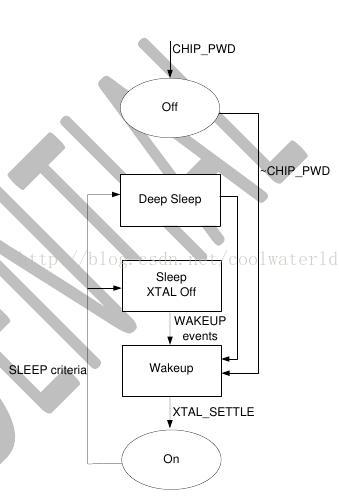大多数IOT利用是电池供电的,在电池电量1定的情况下(体积、环境等限制),耗电量决定了产品的寿命,决定了产品是不是实用。本文主要目的是学习关于NodeMCU的休眠机制。
https://github.com/nodemcu/nodemcu-firmware/wiki/nodemcu_api_en#nodedsleep
Enter deep sleep mode, wake up when timed out.
node.dsleep(us, option)
Note: This function can only be used in thecondition that esp8266 PIN32(RST) and PIN8(XPD_DCDC aka GPIO16) areconnected together. Using sleep(0) will set no wake up timer, connecta GPIO to pin RST, the chip will wake up by a falling-edge
on pinRST.
option=0, init data byte 108 is valuable;
option>0,init data byte 108 is valueless.
More details as follows:
0,RF_CAL or not after deep-sleep wake up, depends on init data byte108.
1, RF_CAL after deep-sleep wake up, there will belargecurrent.
2, no RF_CAL after deep-sleep wake up, there will only besmall current.
4, disable RF after deep-sleep wake up, just likemodem sleep, there will be the smallest current.
us: number(Integer) or nil,sleep time in micro second. If us = 0, it will sleep forever. If us= nil, will not set sleep time.
option: number(Integer) or nil.If option = nil, it will use last alive setting as default option.
nil
https://github.com/nodemcu/nodemcu-firmware/blob/fa7cf87832fc9905df98f9435c149d40f314dee8/app/modules/node.c
static int node_deepsleep( lua_State* L)
{
s32 us, option;
//us = luaL_checkinteger( L, 1 );
// Set deleep option, skip if nil
if ( lua_isnumber(L, 2) )
{
option = lua_tointeger(L, 2);
if ( option < 0 || option >4)
return luaL_error( L, "wrongarg range" );
else
deep_sleep_set_option( option);
}
// Set deleep time, skip if nil
if ( lua_isnumber(L, 1) )
{
us = lua_tointeger(L, 1);
// if ( us <= 0 )
if ( us < 0 )
return luaL_error( L, "wrongarg range" );
else
system_deep_sleep( us );
}
return 0;
}
https://github.com/nodemcu/nodemcu-firmware/blob/84a9ab35a8eb9b4ae2229bba7b2626c2a285818d/include/user_interface.h
bool system_deep_sleep_set_option(uint8option);
void system_deep_sleep(uint32time_in_us);
http://www.seeedstudio.com/document/pdf/ESP8266%20Specifications%28Chinese%29.pdf
10电源管理
芯片可以调成以下状态:

关闭(OFF):CHIP_PD管脚处于低功率状态。RTC失效。所有寄存器被清空。
深度 睡眠( DEEP_SLEEP ) : RTC开着,芯片的其他部份都是关着的。RTC内部recovery memory 可保存基本的WiFi连接信息。
睡眠(SLEEP):只有RTC在运行。晶体振荡器停止。任何部位唤醒(MAC、主机、RTC计时器、外部中Sleep断)将使唤醒全部芯片。
唤醒(WAKEUP):在这类状态下,系统从睡眠状态下转为起动(PWR)状态。晶体振荡器和PLL均转为使能状态。
开启状态(ON):高速时钟可以运行,并发送至各个被时钟控制寄存器使能的模块。各个模块,包括CPU在内,履行较低电平的时钟门控。系统运作时,可以通过WAITI指令关闭CPU内部时钟。
The following data are based on a 3.3V power supply, ambienttemperature 25C and use the internal regulator measured. [1] Allmeasurements are made in the absence of the SAW filter, the antennainterface is completed. [2] all transmit data based on 90% dutycycle, continuous transmission mode in the measured.
|
Mode |
Min |
Typical |
Max |
Units |
|---|---|---|---|---|
|
802.11b, CCK 1Mbps, POUT=+19.5dBm |
215 |
mA |
||
|
802.11b, CCK 11Mbps, POUT=+18.5dBm |
197 |
mA |
||
|
802.11g, OFDM 54Mbps, POUT=+16dBm |
145 |
mA |
||
|
802.11n, MCS7, POUT =+14dBm |
135 |
mA |
||
|
802.11b, packet size of 1024 bytes, ⑻0dBm |
60 |
mA |
||
|
802.11b, packet size of 1024 bytes, ⑺0dBm |
60 |
mA |
||
|
802.11b, packet size of 1024 bytes, ⑹5dBm |
62 |
mA |
||
|
Standby |
0.9 |
uA |
||
|
Deep sleep |
10 |
mA |
||
|
Saving mode DTIM 1 |
1.2 |
mA |
||
|
Saving mode DTIM 3 |
0.86 |
mA |
||
|
Shutdown |
0.5 |
uA |
https://nurdspace.nl/ESP8266#Technical_Overview
Low Power ESP8266
